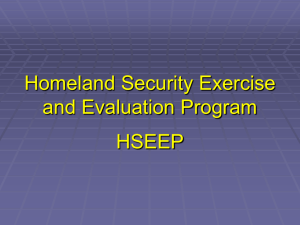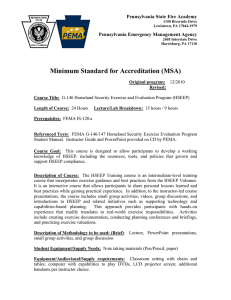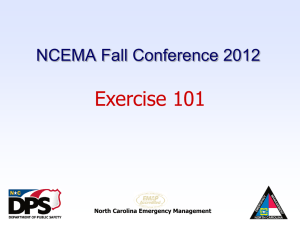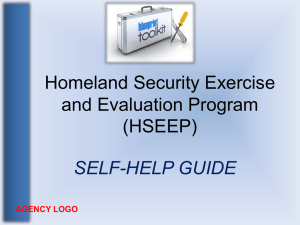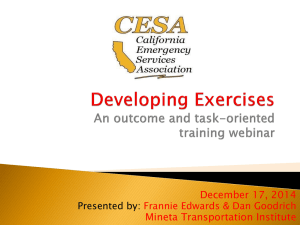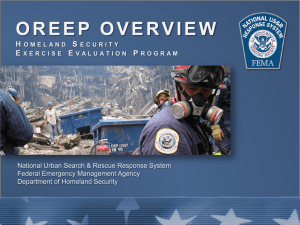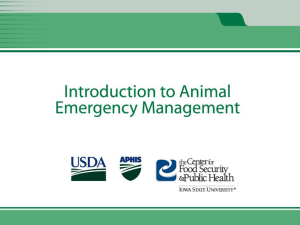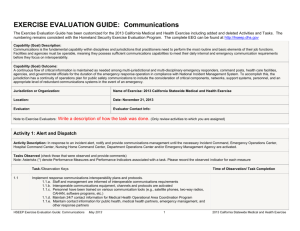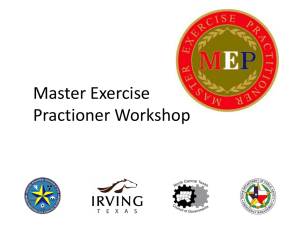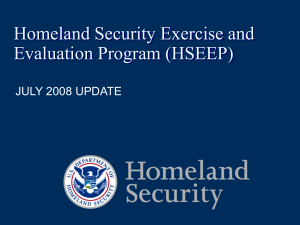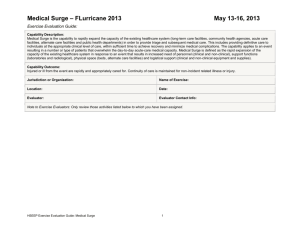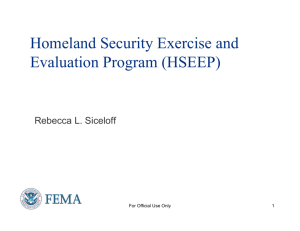February 2010 Instructor's Guide (MS Word format)
advertisement
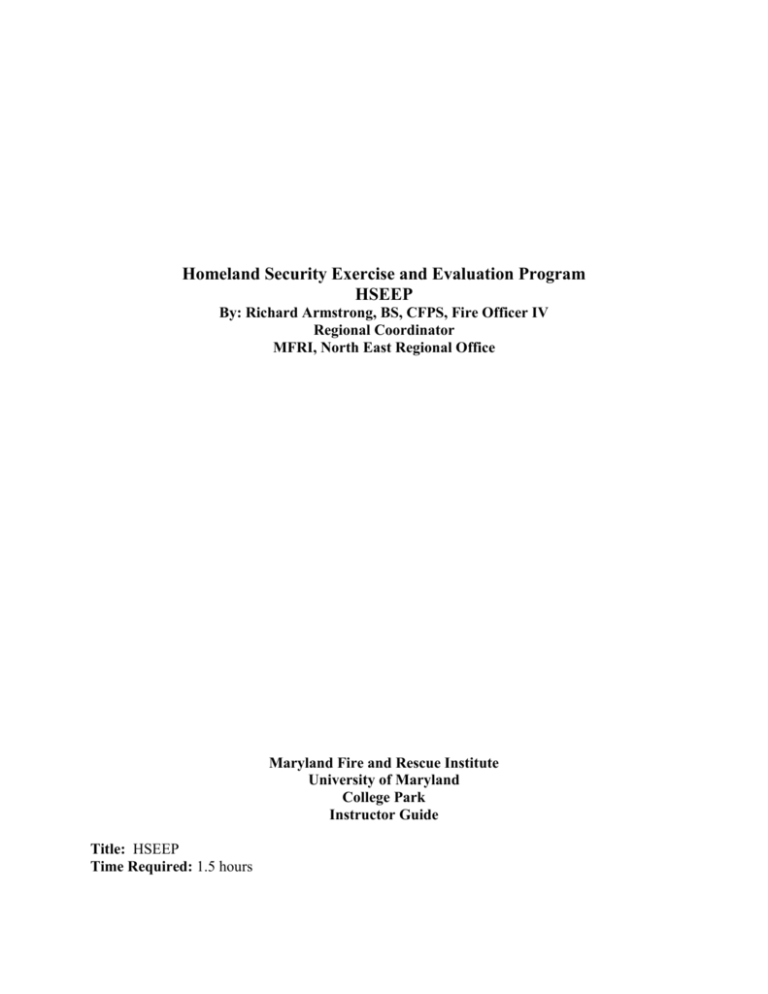
Homeland Security Exercise and Evaluation Program HSEEP By: Richard Armstrong, BS, CFPS, Fire Officer IV Regional Coordinator MFRI, North East Regional Office Maryland Fire and Rescue Institute University of Maryland College Park Instructor Guide Title: HSEEP Time Required: 1.5 hours Drill of the Month – January 2010 Page 2 of 6 Teaching/Learning Materials: LCD projector, laptop computer, accompanying PowerPoint Slides , Internet connection Motivation: Effective exercises are the best way to determine a jurisdiction's readiness to handle a major incident such as a terrorist attack, hurricanes or any other incident that stresses the emergency response capabilities of a state, county or local response capability. Fire and rescue response organizations will be key participants in the development and conduct of these exercises. Student Performance Objectives: At the conclusion of this session, the student will be introduced to the Homeland Security Exercise and Evaluation Program and have the knowledge to access additional information. Enabling Objectives: List the components of the National Preparedness System ( NPS) Describe Exercise Program Management Describe the Training and Exercise Planning Workshop Describe the Exercise Planning Team List the Exercise Planning Conferences Discuss the uses for the HSEEP Toolkit Discuss the reasons for the After-Action Conference Overview: I. Introduction Exercise Program Management Training and Exercise Planning Workshop Exercise Planning Team Exercise Planning Conferences HSEEP Toolkit Improvement Planning Introduction. A. HSEEP - The Homeland Security Exercise and Evaluation Program Drill of the Month – January 2010 B. II. Page 3 of 6 The National Preparedness System (NPS) is based on the Homeland Security Act of 2002. NPS consists of six documents: 1. National Preparedness Goal: "To achieve and sustain capabilities that enable the Nation to collaborate in successfully preventing attacks on the homeland, and rapidly and effectively responding to and recovering from any terrorist attack, major disaster, or other emergency that does occur to minimize the impact on lives, property and the economy. The state of national preparedness will be achieved by reaching risk-based target levels of capability and sustained by measuring readiness and directing resources to areas of greatest risk and need." 2. National Planning Scenarios: Will be used to illustrate the potential scope, magnitude, and complexity of a plausible range of major events 3. Universal Task List: Provides a menu of tasks from all sources that may be performed in major events such as those illustrated by the National Planning Scenarios. 4. Target Capabilities List: Provides guidance on the specific capabilities and levels of capability that Federal, State tribal and local entities will be expected to develop and maintain, 5. National Response Framework: It is a guide to how the Nation conducts all-hazards response. This document replaces the National Response Plan. It describes specific authorities and best practices for managing incidents that range from the serious but purely local, to large-scale terrorist attacks or catastrophic natural disasters. IS-800 is a course that explains the background and procedures in the National Response Framework. This can be accessed at the following web page: http://training.fema.gov/EMIWeb/IS/IS800b.asp 6. National Incident Management System: a. Incident Command System b. Communication and Information Management c. Preparedness d. Joint Information System e. NIMS Resource Center - http://www.fema.gov/emergency/nims/ Exercise Program Management. A. Capabilities -Based Planning - It is defined as planning, under uncertainty, to build capabilities suitable for a wide range of threats and hazards while working within an economic framework that necessitates prioritization and choice. B. Priorities are selected by pulling together information from Capabilities Assessments and Improvement Plans from previous exercises. C. Implementing an Exercise Program - The Homeland Security Program Strategy addresses how the jurisdiction plans to reduce preparedness gaps identified in the Capabilities Assessment. D. Components of the Strategy 1. Exercises Drill of the Month – January 2010 2. 3. 4. Page 4 of 6 a. Tabletop Exercises b. Functional Exercises c. Full-Scale Exercises Training Equipment Personnel III. Training and Exercise Planning Workshop. A. T&PW is a forum for developing, reviewing, or updating a Multi-Year Training and Exercise Plan and Schedule. 1. Key element of HSEEP 2. Gives an opportunity for the entire State discuss the State Homeland Security Strategy 3. Review accomplishments over the previous year 4. A large part of the workshop should be spent scheduling exercises 5. Workshops can also be scheduled at the local level 6. The Multi-.Year Training and Exercise Plan is produced at the T&EP workshop. The program outlines program priorities and target capabilities. The training and exercise schedule is completed. IV. Exercise Planning Team. A. The Exercise Planning Team is the backbone of the exercise because the planning team members develop the foundation upon which the rest of the exercise is built. The level of interest, cooperation, and commitment from members can be the difference between a successful and unsuccessful exercise. B. The Exercise Planning Teams develop, design, conduct and evaluate exercises. They determine exercise objectives, create scenarios and develop documentation. Members conduct exercise briefings and training sessions. C. Exercise Planning Team Structure. The Incident Command System can be used as the basis for the organizational structure. 1.Command - Planning Team Leader 2.Operations - Select exercise design objectives and design the scenarios. Representatives from all key agencies participate. 3.Planning - Responsible for the exercise evaluation. Select Exercise Evaluation guides that follow the exercise objectives. 4.Logistics - Coordinates all support activities for the exercise. 5.Finance/Administration - monitors and tracks the cost of the exercise. 6.Subject Matter Experts (SMEs) - add functional knowledge and expertise to the Exercise Planning Team. They help make the scenario realistic and plausible and insure jurisdictions have appropriate capabilities to respond. V. Exercise Planning Drill of the Month – January 2010 C. D. E. F. G. Page 5 of 6 A Planning Conference is a meeting to discuss, review, or develop exercise content and typically involves a face-to-face meeting. The conference is a good place to assess progress , assign responsibilities, and review completed work.. Concepts and Objectives Meeting - Used to identify overall exercise goals and planning team members. Initial Planning Conference - The following outcomes are expected; measureable objectives and scenario location, completion of exercise documents, and a planning schedule. Midterm Planning Conference - Discussions should address exercise organization and staffing issues, scenario and timeline development, scheduling, logistics, and administration requirements. Planners should conduct a walkthrough of the exercise location. Final Planning Conference - Finalize documentation and support requirements, exercise materials distributed, and jurisdiction completes training for the exercise. VI. HSEEP Toolkit. C. The HSEEP Toolkit is a project management tool. Access to the HSEEP Toolkit must be granted by the Preparedness Directorate's Office of Grants and Training. D. HSEEP Toolkit functions: 1. Customize a schedule for the exercise 2. Establish a list of tasks to be completed 3. Templates for important exercise documents 4. Step-by-step instructions for first time users 5. Send automated emails to remind exercise planners of important tasks to be completed 6. http://hseep.dhs.gov VII. Improvement Planning B. After-Action Planning Conference - To ensure effective improvements are identified, it is imperative the After-Action conference be held in a timely manner to maintain the momentum of the exercise and keep the recollections of the participants as fresh as possible. C. After-Action Conferences often require an entire day and should be scheduled after the draft After Action Report is distributed to all participants D. The After-Action Conference covers specific actions that jurisdictions/organizations can take to address areas for improvement, feedback, and validation on observations and recommendations, and the document use for the After Action Report/Improvement Plan. Summary: At the conclusion of this session, the student will be introduced to the Homeland Security Exercise and Evaluation Plan. This plan is the basis for all exercises sponsored and /or facilitated by the federal government. Drill of the Month – January 2010 Review: Introduction Exercise Program Management Training and Exercise Planning workshop Exercise Planning Team Exercise Planning Conferences HSEEP Toolkit Improvement Planning Reference Material: www.fema.gov/pdf/government/npg.pdf https://hseep.dhs.gov/ www.dhs.gov/files/publications/gc_1189788256647.shtm https://hseep.dhs.gov/pages/1001_About.aspx https://hseep.dhs.gov/pages/1001_About.aspx https://hseep.dhs.gov/support/TEPW_Users_Handbook_(V30).pdf https://hseep.dhs.gov/pages/1001_HSEEP7.aspx Page 6 of 6
